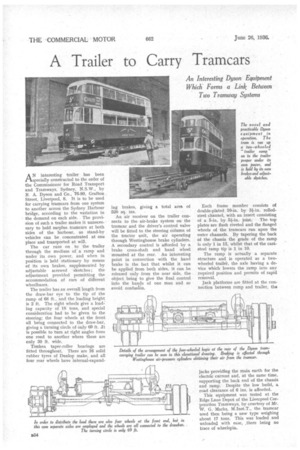A Trailer to Carry Tramcars
Page 96

If you've noticed an error in this article please click here to report it so we can fix it.
An Interesting Dyson Equipment Which Forms a Link Between Two Tramway Systems
AN interesting trailer has been .specially constructed to the order of the Commissioner for Road Transport and Tramways, Sydney, N.S.W., by R. A. Dyson and Co., 76-80, Grafton, Street. Liverpool, 8. It is to be used for carrying tramcars from one system to another across the Sydney Harbour bridge, according to the variation in the demand on each side. The provision of such a trailer makes it unnecessary to hold surplus tramcars at both sides of the harbour, as stand-by vehicles can be concentrated at one place and transported at will.
The car runs on to the trailer through the medium of a ramp and under its own power, and when in position is held stationary by means of its own brakes, supplemented by adjustable screwed -skotches ; the adjustment provided permitting the accommodation of cars of different wheelbases.
The trailer has an overall length from the draw-bar eye to the tip of the ramp of 68 ft., and the loading height is 2 ft. The eight wheels give a load= ing capacity of 18 tons, and special consideration had to be given to the steering; the four wheels at the front all being connected to the draw-bar, giving a turning circle of only 69 ft. a is possible to turn at right angles from one road to another where these are only 30 ft. wide.
Timken taper-roller bearings are fitted throughout. There are 16 solid rubber tyres of Dunlop make, and all four rear wheels have internal-expand
ing brakes, giving a total area of 520 sq. ins.
An air receiver on the trailer connects to the. air-brake system on the tramcar and the driver's control valve will be fitted to the steering column of the tractor unit, the air operating through Westinghouse brake cylinders. A secondary control is afforded by a brake cross-shaft and hand wheel mounted at the rear. An interesting point in connection with the hand brake is the fact that whilst it can be applied from both sides, it can be released only from the near side, the object being to give the final control into the hands of one man and so avoid confusion.
Each frame member consists of double-plated 10-in. by 3i-in. rolledsteel channel, with an insert consisting Of a 5-in. by 54-in. joist. The top plates are flush riveted and the flanged wheels of the tramcars run upon the outer channels. By tapering the back of the chassis the grade of the ramp is only 1 in 13, whilst that of the caststeel ramp tip is 1 in 10.
The ramp is actually a separate structure and is operated as a twowheeled trailer, the axle having a device which lowers the ramp into any required position and permits of rapid removal.
Jack platforms are fitted at the connection between ramp and trailer, the jacks providing the main earth for the electric current and, at the same time, supporting the back end of the chassis and ramp. Despite the low build, a road clearance of 6 ins, is afforded.
This equipment was tested at the Edge Lane Depot of the Liverpool Corporation Tramways, by courtesy of Mr. W. G. Marks, M.Inst.T., the tramcar used then being a new type weighing about 17 tons. This was loaded and unloaded with ease, _there being no trace of wheelspin.












































































































































